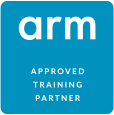Commands Sheet for Linux, Yocto & Git
This "Linux, Yocto & Git" commands booklet from the Doulos Embedded technical team, provides a handy reminder of how to work on the command line, with examples of how to work with files and folders, searching, managing archives and much more.
Embedded Linux: Debugging User Space Seg Fault
In this article Simon Goda from Doulos Embedded takes a brief look at some of the tools there are available in a typical embedded Linux development environment, which can help track down problems.
Here you will find some short technical articles relating to the use of the Arm instruction set.
Configuring (X)Emacs for Arm RVCT
In this article Marcus Harnisch from Doulos introduces Emacs as an editor that can be customized easily to support Arm's RealView Compilation Tools (RVCT).
Implementing Semaphores on Arm processors
Semaphores are used to manage access to a shared resource. Depending on the type of semaphore, one or more clients may be granted access.
Efficient byte swapping of data blocks in Armv6 and Armv7-A/R
Since the introduction of the Arm11 processor family, the Arm instruction set supports on-the-fly switching of the current endian mode. Natively a little endian architecture, the processor can be put into a big endian mode to process chunks of data in that format. DSPs, network adapters and similar peripherals might return processed data in big endian format.
For further information about the Doulos Arm training portfolio visit www.doulos.com/arm
Arm is a registered trademark, and Cortex is a trademark of Arm Holdings Plc.
Introduction to C++ casting issues
This article example helps you to understand how to make good decisions using implict, explict conversions and casting in C++.
Introduction to C++ operator overloading
This article helps you understand how C++ operator overloading provides useful abstraction, both inside a class and outside.





